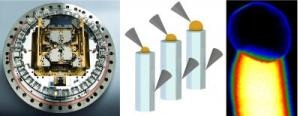Jan 20 2017
 Specialist research equipment and reseach images. (Credit: Scienta Omicron)
Specialist research equipment and reseach images. (Credit: Scienta Omicron)
Swansea University researchers are exploring the possibilities of addressing the challenge of integrating nanoscale structures into next-generation semiconductor devices. Such advancements not only lead to the development of new technologies, but also influence all aspects of day-to-day life.
The collaborative research reported in Nano Letters was headed by Dr Alex Lord and Professor Steve Wilks from the Centre for Nanohealth. The researchers were seeking ways to design electrical contact technology on small scales by making simple and effective changes to nanowires, enabling the development of better devices based on nanomaterials.
It is necessary to have well-defined electrical contacts for any electronic devices and electrical circuits owing to their ability to control the flow of electricity – an essential aspect of the operational capability.
Day-to-day materials that are being reduced to the nanometer size (one million times smaller than a millimeter on a standard ruler) by researchers on a global scale are considered the future of electronic devices. The engineering and scientific developments are resulting in novel technologies such as energy generating clothing to power personal gadgets and sensors for monitoring human health as well as the surrounding environment.
Over the coming years, this development will make a significant contribution to the explosion that is the Internet of Things (IoT), which connects everything ranging from homes to vehicles into a web of communication. Such new technologies need similar developments in electrical circuits, particularly electrical contacts that facilitate the devices to work properly with electricity.
Nanotechnology has delivered new materials and new technologies and the applications of nanotechnology will continue to expand over the coming decades with much of its usefulness stemming from effects that occur at the atomic- or nano-scale. With the advent of nanotechnology, new technologies have emerged such as chemical and biological sensors, quantum computing, energy harvesting, lasers, and environmental and photon-detectors, but there is a pressing need to develop new electrical contact preparation techniques to ensure these devices become an everyday reality.
Professor Steve Wilks, Swansea University
Wilks further added that, “Traditional methods of engineering electrical contacts have been applied to nanomaterials but often neglect the nanoscale effects that nanoscientists have worked so hard to uncover. Currently, there isn’t a design toolbox to make electrical contacts of chosen properties to nanomaterials and in some respects the research is lagging behind our potential application of the enhanced materials.”
In collaboration with Professor Quentin Ramasse of the SuperSTEM Laboratory, Science and Facilities Technology Council, the Swansea scientists1 carried out the research using specialist experimental equipment. In this work, the researchers physically interacted with the nanostructures and measured the effect of the nanoscale modifications on the electrical performance.2
In this work, the scientists determined for the first time, the dominant electrical conduction can be turned-on or turned-off by making simple changes to the catalyst edge, providing a powerful technique using which nanoengineers can choose the properties of manufacturable nanowire devices.
The experiments had a simple premise but were challenging to optimise and allow atomic-scale imaging of the interfaces. However, it was essential to this study and will allow many more materials to be investigated in a similar way. This research now gives us an understanding of these new effects and will allow engineers in the future to reliably produce electrical contacts to these nanomaterials which is essential for the materials to be used in the technologies of tomorrow. In the near future this work can help enhance current nanotechnology devices such as biosensors and also lead to new technologies such as Transient Electronics that are devices that diminish and vanish without a trace which is an essential property when they are applied as diagnostic tools inside the human body.
Dr Alex Lord, Swansea University
References
1. Lord, A. M., Ramasse, Q. M., Kepaptsoglou, D. M., Evans, J. E., Davies, P. R., Ward, M. B. & Wilks, S. P. 2016 Modifying the Interface Edge to Control the Electrical Transport Properties of Nanocontacts to Nanowires. Nano Lett. (doi:10.1021/acs.nanolett.6b03699). http://pubs.acs.org/doi/abs/10.1021/acs.nanolett.6b03699
2 .Lord, A. M. et al. 2015 Controlling the electrical transport properties of nanocontacts to nanowires. Nano Lett. 15, 4248–4254. (doi:10.1021/nl503743t) http://pubs.acs.org/doi/abs/10.1021/nl503743t